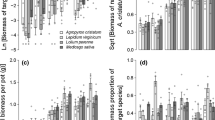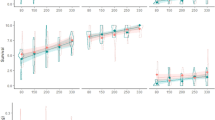Abstract
Numerous studies show that an increase in the availability of limiting resources can increase invasion by non-native plants into natural communities. One possible explanation is that the ability of natives to compete with non-natives tends to decrease when resource availability is increased. We tested this hypothesis in a competition experiment using two closely matched plant species and two environmental factors related to limiting resources in a coastal grassland system on Bodega Head in northern California. We grew the native grass Bromus carinatus and the non-native grass B. diandrus together and apart at different levels of soil nitrogen crossed with different levels of soil salinity. Both species are abundant in the grassland and previous work suggested that the abundance of B. carinatus is lower and the abundance of B. diandrus is higher on soil that has been enriched with nitrogen. Salinity has been shown to be negatively associated with invasion by B. diandrus into another California grassland, and to vary significantly over short distances in the grassland at Bodega Head, where it could affect water availability, which strongly limits plant growth during the dry season. Contrary to our prediction that low resource availabilities would increase the relative competitive ability of the native, the ability of B. carinatus to compete with B. diandrus was not greater when nitrogen availability was lower or when soil salinity was higher. Instead, high salinity increased the relative competitive ability of the non-native, and low nitrogen had little effect on competition. This suggests that preventing resource enrichment will not suffice to control invasion by non-native plant species in this grassland.
Similar content being viewed by others
References
Alpert P (1991) Nitrogen sharing among ramets increases clonal growth in Fragaria chiloensis. Ecology 72: 69–80
Alpert P, Bone E and Holzapfel C (2000) Invasiveness, invasibility and the role of environmental stress in the spread of non-native plants. Perspectives in Plant Ecology, Evolution and Systematics 3: 52–66
Alpert P and Maron JL (2000) Carbon addition as a countermea-sure against biological invasion by plants. Biological Invasions 2: 33–40
Barbour MG (1978) The effect of competition and salinity on the growth of a salt marsh plant species. Oecologia 37: 93–99
Barbour MG, Craig RB, Drysdale FR and Ghiselin MT (1973) Coastal Ecology: Bodega Head. University of California Press, Berkeley
Blicker PS, Olson BE and Engel R (2002) Traits of the invasive Centaurea maculosa and two native grasses: effect of N supply. Plant and Soil 247: 261–269
Callaway JC and Zedler JB (1998) Interactions between a salt marsh native perennial (Salicornia virginica) and an exotic annual (Polypogon monspeliensis) under varied salinity and hydroperiod. Wetlands Ecology and Management 5: 179–194
Claassen VP and Marler M(1998) Annual and perennial grass growth on nitrogen-depleted decomposed granite. Restoration Ecology 6: 175–180
Davis MA, Grime JP and Thompson K (2000) Fluctuating resources in plant communities: a general theory of invisibility. Journal of Ecology 88: 528–534
Firbank LG and Watkinson AR (1990) On the effects of competition: from monocultures to mixtures. In: Grace JB and Tilman D (eds) Perspectives on Plant Competition, pp 165–192. Academic Press, San Diego, California.
Greiner La Peyre MK, Grace JB, Hahn E and Mendelssohn IA (2001) The importance of competition in regulating plant species abundance along a salinity gradient. Ecology 82: 62–69
Heady HF (1977) Valley grassland. In: Barbour MG and Major J (eds) Terrestrial Vegetation of California, pp 491–514. Wiley, New York
Heady HF, Foin TC, Hektner MM, Taylor DW, Barbour MG and Barry WJ (1995) Coastal prairie and northern coastal scrub. In: Barbour MG and Major J (eds) Terrestrial Vegetation of California, pp 733–759. Wiley, New York
Hickman JC (ed) (1993) The Jepson Manual: Higher Plants of California. University of California Press, Berkeley
Hobbs RJ and Atkins L (1988) Effect of disturbance and nutrient addition on native and introduced annuals in plant communities in the Western Australian wheat-belt. Australian Journal of Ecology 13: 171–179
Hobbs RJ and Mooney HA (1991) Effects of rainfall variability and gopher disturbance on serpentine annual grassland dynamics. Ecology 72: 59–68
Hoopes LF and Hall LM (2002) Edaphic factors and competition affect pattern formation and invasion in a California grassland. Ecological Applications 12: 24–39
Jackson LE (1985) Ecological origins of California's mediterranean grasses. Journal of Biogeography 12: 349–361
Jakobsson A and Eriksson O (2000) A comparative study of seed number, seed size, seedling size and recruitment in grassland plants. Oikos 88: 494–502
Kenkel NC, McIlraith AL, Burchill CA and Jones G (1991) Competition and the response of three plant species to a salinity gradient. Canadian Journal of Botany 69: 2497–2502
Kolb A (1999) Patterns of biological invasions in a California coastal grassland – the role of environmental stress. MSc Thesis, Plant Biology Graduate Program, University of Massachusetts Amherst, 96 pp
Kolb A, Alpert P, Enters D and Holzapfel C (2002) Patterns of invasion within a grassland community. Journal of Ecology 90: 871–881
Kuhn NL and Zedler JB (1997) Differential effects of salinity and soil saturation on native and exotic plants of a coastal salt marsh. Estuaries 20: 391–403
Leishman MR (2001) Does the seed size/number trade-off model determine plant community structure? An assessment of the model mechanisms and their generality. Oikos 93: 294–302
Maron JL and Connors PG (1996) A native nitrogen-fixing shrub facilitates weed invasion. Oecologia 105: 302–312
Maron JL and Jefferies RL (1999) Bush lupine mortality, altered resource availability and alternative vegetation states. Ecology 80: 443–454
Mooney HA, Hamburg SP and Drake JA (1986) The invasions of plants and animals into California. In: Mooney HA and Drake JA (eds) Ecology of Biological Invasions of North America and Hawaii, pp 250–272. Springer, New York
Muller B and Garnier E (1990) Components of relative growth rate and sensitivity to nitrogen availability in annual and perennial species of Bromus. Oecologia 84: 513–518
Nernberg D and Dale MRT (1997) Competition of five native prairie grasses with Bromus inermis under three moisture regimes. Canadian Journal of Botany 75: 2140–2145
Noe GB and Zedler JB (2000) Differential effects of four abiotic factors on the germination of salt marsh annuals. American Journal of Botany 87: 1679–1692
Noe GB and Zedler JB (2001) Spatio-temporal variation of salt marsh seedling establishment in relation to the abiotic and biotic environment. Journal of Vegetation Science 12: 61–74
Turnbull LA, Rees M and Crawley MJ (1999) Seed mass and the com-petition/ colonization trade-off: A sowing experiment. Journal of Ecology 87: 899–912
Weber E and D'Antonio CM (1999) Germination and growth responses of hybridizing Carpobrotus species (Aizoaceae) from coastal California to soil salinity. American Journal of Botany 86: 1257–1263
Wedin D and Tilman D (1993) Competition among grasses along a nitrogen gradient: Initial conditions and mechanisms of competition. Ecological Monographs 63: 199–229
Wedin DA and Tilman D (1996) Influence of nitrogen loading and species composition on the carbon balance of grasslands. Science 274: 1720–1723
Welker JM, Gordon DR and Rice KJ (1991) Capture and allocation of nitrogen by Quercus douglasii seedlings in competition with annual and perennial grasses. Oecologia 87: 459–466
Westoby M, Jurado E and Leishman M (1992) Comparative evolu-tionary ecology of seed size. Trends in Ecology and Evolution 7: 368–372
White TA, Campbell BD and Kemp PD (1997) Invasion of temperate grassland by a subtropical annual grass across an experimental matrix of water stress and disturbance. Journal of Vegetation Science 8: 847–854
Author information
Authors and Affiliations
Corresponding author
Rights and permissions
About this article
Cite this article
Kolb, A., Alpert, P. Effects of Nitrogen and Salinity on Growth and Competition Between a Native Grass and an Invasive Congener. Biological Invasions 5, 229–238 (2003). https://doi.org/10.1023/A:1026185503777
Issue Date:
DOI: https://doi.org/10.1023/A:1026185503777




